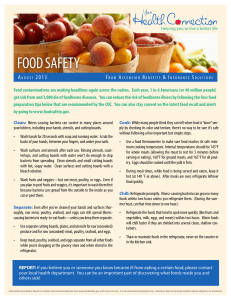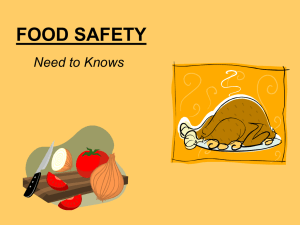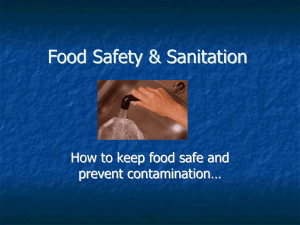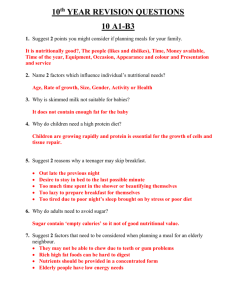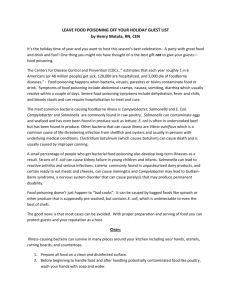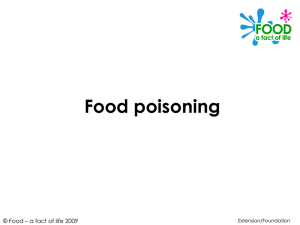FOOD SAFETY Have you ever had Food Poisoning?
advertisement
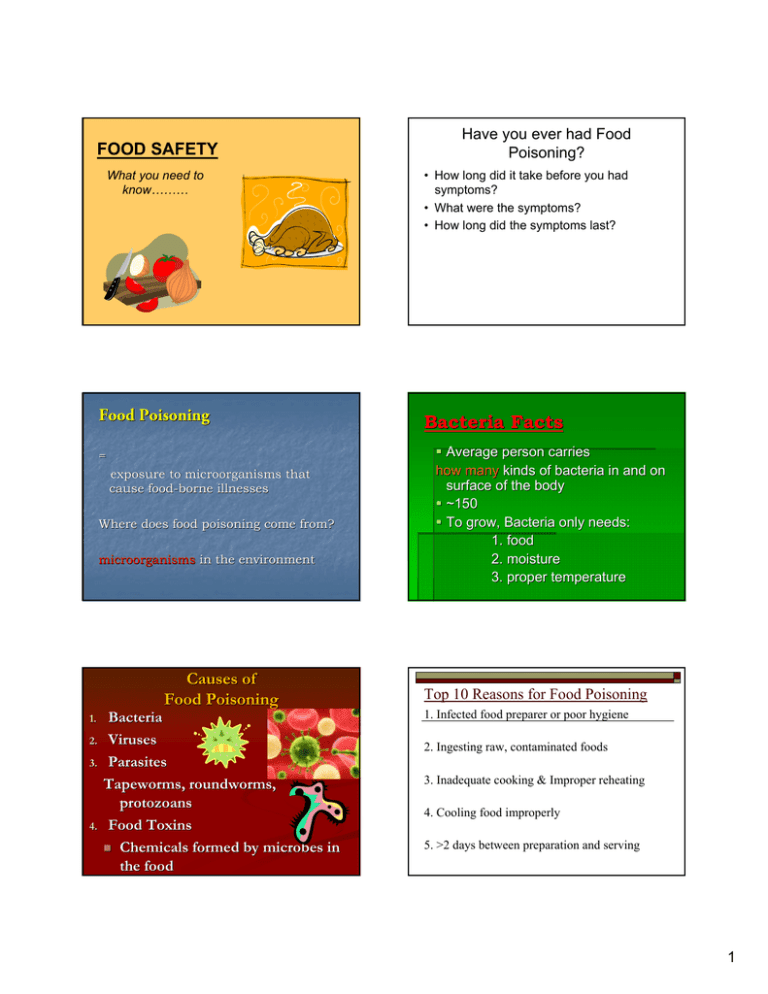
FOOD SAFETY What you need to know……… Food Poisoning = exposure to microorganisms that cause foodfood-borne illnesses Where does food poisoning come from? microorganisms in the environment Causes of Food Poisoning 1. 2. 3. 4. Bacteria Viruses Parasites Tapeworms, roundworms, protozoans Food Toxins Chemicals formed by microbes in the food Have you ever had Food Poisoning? • How long did it take before you had symptoms? • What were the symptoms? • How long did the symptoms last? Bacteria Facts Average person carries how many kinds of bacteria in and on surface of the body ~150 To grow, Bacteria only needs: 1. food 2. moisture 3. proper temperature Top 10 Reasons for Food Poisoning 1. Infected food preparer or poor hygiene 2. Ingesting raw, contaminated foods 3. Inadequate cooking & Improper reheating 4. Cooling food improperly 5. >2 days between preparation and serving 1 Top 10 Reasons for F.B.I. Ideal Conditions for Bacterial Growth 6. Cross-contamination Food (protein) 7. Toxins (chemical contamination) Acid (ideal acidity = pH >4.6) 8. Unsafe food sources (i.e. meat not inspected by the USDA) Temperature (“ (“Danger Zone” Zone” = 41o F – 140o F) 9. Inadequate cleaning of equipment 10. Poor storage practices F.A.T. T.O.M. Combined, these conditions lead to rapid growth. Time Oxygen Moisture Food Preservation 1. Dry the foods ¿why does dry food last longer? (no moisture for growth) 2. Add salt or sugar ¿why would this help preserve food? decreases available water 3. Make food acidic ¿why would this help preserve food? pH <4.6 keeps bacteria from growing Safe Heating Temperatures • Fish 145 º F Safe Heating Temperatures • Pork 160 º F 2 Safe Heating Temperatures Safe Heating Temperatures • Poultry 180 º F • Beef 160 º F • Ground Beef 160 º F Safe Heating Temperatures • Reheating all foods 170 º F Prevention of Cross Contamination 1. Wash your hands!! 2. Wash foods 3. Clean & sanitize food contact surfaces & utensils Food Storage Hazards – Bacteria (common) • z Refrigeration z Reduces growth of most organisms z Freezing z H2O in the form of ice – is unavailable for biological rxns Escherichia coli • Undercooked beef or contaminated produce • Staphylococci • Contamination from skin 3 Hazards – Bacteria (common) Salmonella • • • Undercooked eggs, poultry cross-contamination of produce Clostridium perfringens • • Food temps. in the “Danger Zone” Hazards – Bacteria (common) • Bacillus cereus Food temps. in the “Danger Zone” • Clostridium botulinum • Improperly canned foods • Bacteria produce a nerve toxin • Spores have been found in honey Æ DON’T feed honey to children <1 year old Hazards – Viruses (common) Symptoms of Food Poisoning • Norovirus • Poor hygiene = Fecal to oral contaminant • A very hardy virus – hard to disinfect surfaces • Famous for cruise-ship epidemics Symptoms of Food Poisoning • • • • • Botulism symptoms Double or blurred vision Difficulty swallowing Dry mouth Droopy eyelids Muscle weakness 1. Nausea 2. Diarrhea 3. Abdominal cramps 4. Vomiting 5. Fever 6. Dizziness 7. Headaches 8. Dehydration 10 Food-Handling Tips to Prevent F.B.I. 1. No cans or glass jars with dents, cracks or bulging lids. 2. Never eat raw meat, poultry, seafood or eggs. 3. Cook raw meat, poultry, seafood or eggs thoroughly to kill any bacteria present. Thoroughly reheat leftovers. 4. Promptly refrigerate cooked meat and poultry in small shallow containers. Remove stuffing from chicken and turkey and refrigerate separately. 5. Refrigerate perishable food as soon as you get home from the market. 4 10 Food-Handling Tips to Prevent F.B.I. Don’t Take Chances 6. Store canned goods in a cool, dry place for use within a year. Never put them above the oven or in a damp area. 7. Thaw food in the refrigerator or in the microwave just before cooking. (NOT on the counter.) 8. Keep work areas clean. Wash hands, utensils and cutting boards in hot soapy water before preparing food and after handling raw meat or poultry. • If you suspect there’s a problem, throw the food out. • WHEN IN DOUBT, THROW IT OUT!! 9. Use a plastic or other nonporous cutting board. 10. Keep pets away from the food, cooking and eating surfaces, and equipment. 5
